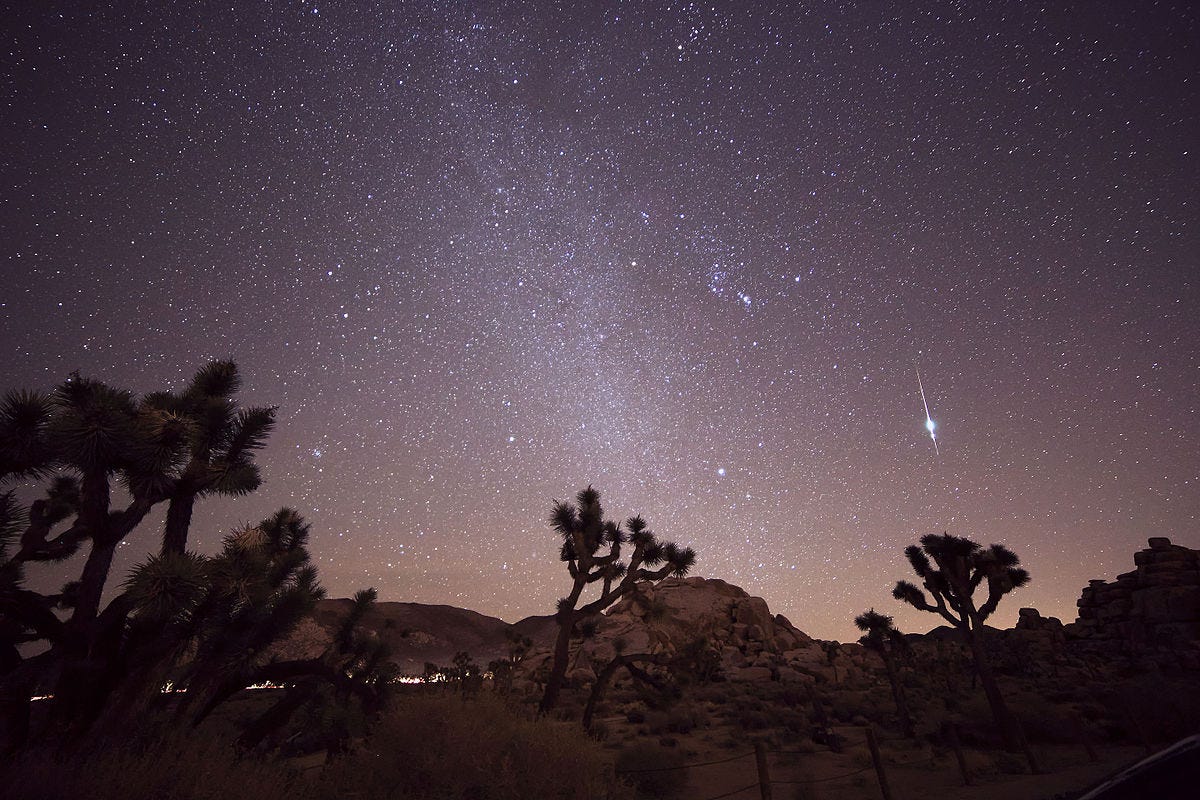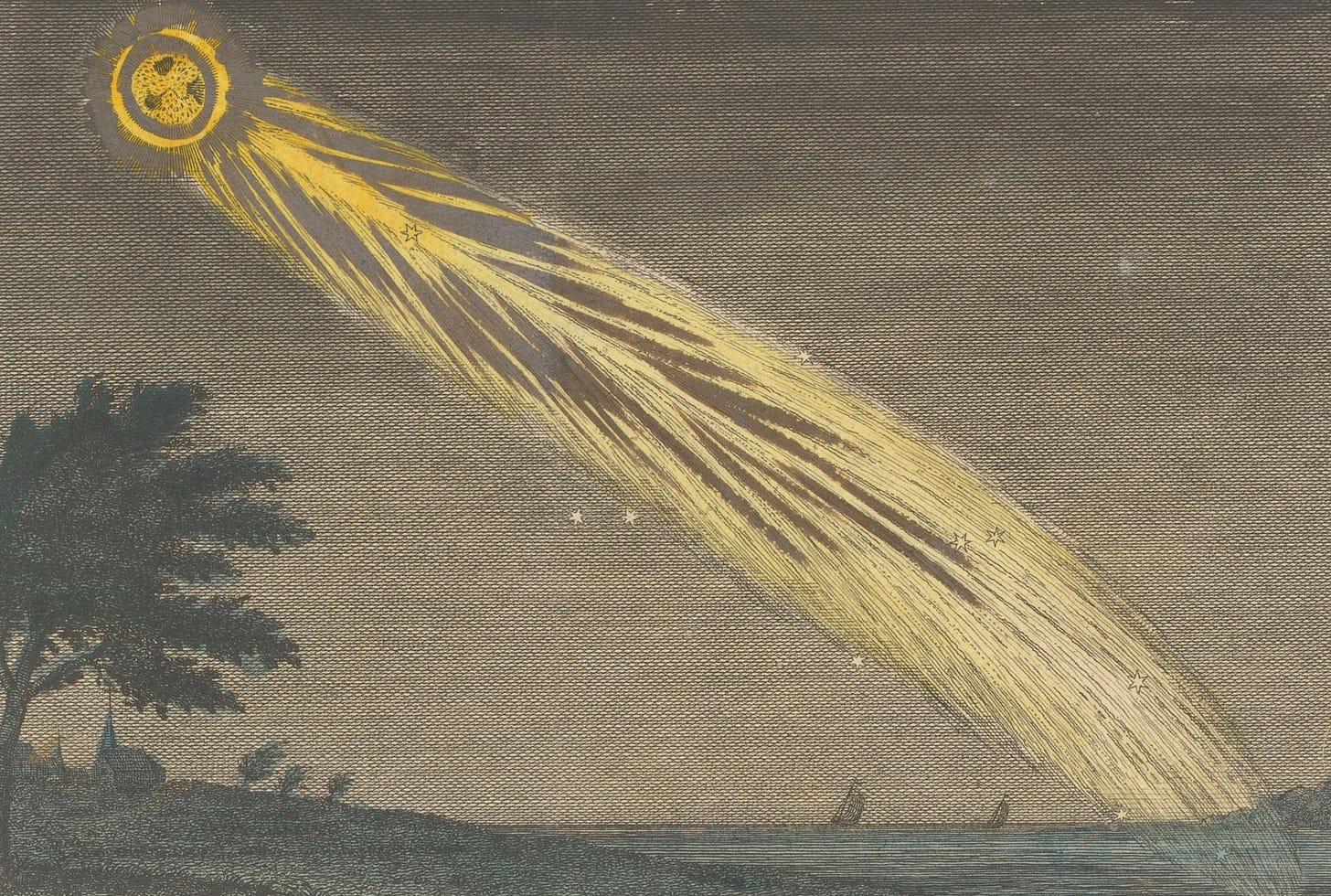Dear word explorer,
Our sun is hopping like a popcorn pan at the moment, and it fired the most powerful solar flare of this solar cycle so far - an X9.1 - Earthward on the 3rd of October. The Coronal Mass Ejection (CME) that followed hit the planet’s magnetosphere on the 6th and 7th of October, offering up some beautiful auroras around the globe. We even saw some effects here in Galway.

Yesterday, a X2.1 flare with an associated CME shot off towards Earth.
Comet Tsuchinshan-ATLAS is directly in the path of this CME, and it will collide with the comet (today or early on the 9th of October) before it washes over Earth’s magnetosphere. There’s a likelihood that the wave of solar plasma will burn off the comet’s beautiful long tail of dust and ice particles — this was the fate of Comet Enke back in April 2007.
Encke is a regular visitor, with 3.3 year-long solar orbit. It was first recorded by French astronomer Pierre Méchain in 1786, but it wasn’t until 1819 that German astronomer Johann Franz Encke calculated its orbit and realised it was a repeating comet. This orbit can be perturbed by the gravitational pull of the planets Encke passes on its set route, and every 33 years it makes its closest pass of the Earth.
Astronomers suspected that Encke is a remanent of a much larger comet that broke up 20,000 to 30,000 years ago. This is partly due to its association with the annual meteor showers known as the Taurids1, named after the constellation Taurus. They have the terrific nickname of ‘Halloween fireballs’ because the Taurid meteors tend to be larger than normal and generate strong ‘shooting stars’.
Recently, it’s been revealed that there are at least 88 objects associated with this Taurid Complex (also known as the Taurid Swarm), and Earth will pass through the densest part of the swarm in 2032.
It’s believed that the Tunguska event of 30 June 1908 was the result of a rogue member of this meteor collective arriving at our doorstep. The resulting air burst (it did not impact the ground) occurred in the sparsely populated Podkamennaya Tunguska River region in Siberia, and flattened an estimated 80 million trees.
This is why initiatives such as the Asteroid Terrestrial-impact Last Alert System (ATLAS), which I mentioned two weeks ago, are so useful to our future.
On top of that, there is other research going on, such as the European Space Agency’s Hera mission, which was successfully launched yesterday.
It’s being described as a ‘crime scene investigation’ of the previous NASA Double Asteroid Redirection Test (DART) project, which in 2022 crashed a probe into the moonlet Dimorphos, which is part of a binary asteroid system which includes Didymos.
I’d recommend watching this fun animation by the ESA which explains the history and remit of the mission, and it will save me from boring you!
I cannot help it, but my myth-obsessed brain always kicks into overdrive when I read about journeys into darkness by objects named after legendary characters. I notice the associations and resonances.
In Greek mythology Hera was one of the most important goddesses of the twelve Olympians dwelling on Mount Olympus. She presided over marriage, weddings, family, and was the divine protector invoked during childbirth. Her Roman equivalent is Juno, from which we get the month of June, which is often a favourite month for weddings and celebrations.
Many of the stories we have about Hera concentrate on her jealousy and elaborate acts of vengeance for the legions of affairs orchestrated by her husband, Zeus. This focus on her being the raging scold erases much of her pre-Greek Earth goddess nature. It’s worth noting that early Hera references associate her with cows and bulls — i.e. a very Taurean aspect.
Dimorphos, or ‘dual-natured’, is one of the epitaphs associated with the god Dionysus, a wild entity of ecstasy and primal liberation. His great invention — wine — can be a joyous libation shared with friends or if overindulged, a greased slope to debauched inebriation. In this fashion you can also consider wine’s potential as ‘dual-natured’.
Didymos means ‘twin’ in Greek, and the main story associated with the name is of an Athenian who was performing a sacrifice when a swift white dog snatched away the offering. In that moment Didymos received an oracular message instructing him to establish a temple to Heracles at the spot where the dog dropped the intended sacrifice.
The resulting construction became Cynosargesa (Kynosarges)2, which involved a temple to Heracles, a public gymnasium, and a grove outside the walls of Athens. The temple also celebrated the mother of Heracles, Alcmene.
All of this is mythically fascinating, since Heracles is the demi-god illegitimate offspring of Zeus, who also had a mortal twin brother called Iphicles. Throughout the life of Heracles, Hera made many attempts to kill him, and she is the reason that he was tasked with the ‘impossible’ twelve labours. Heracles means ‘glory of Hera’; an attempt to soften her vendetta, which did not work.
Heracles had many, many adventures and tragic outcomes, but in one of the stories he challenged the god Dionysus to a drinking contest, and unsurprisingly Heracles lost to the god who invented binging. This resulted in Heracles being forced to join the thiasus, the ecstatic crew of revellers that always accompanied Dionysus.
So in 2026, the Hera spacecraft will be spying upon twinned asteroids, making observations of their composition and behaviour, and beaming the information back to Earth. She will be assessing their dual natures, their interdependence, and from those notes scientists will be able to determine the parentage of the binary asteroids.
Hopefully Hera will not discover traces of Zeus, or the Erinyes (Furies) might be unleashed…

Back to our skies… Comet Tsuchinshan-ATLAS is currently difficult to see due to the sun’s glare, but later this week it will be visible, and astronomers will be checking to see if its tail has been seared off. Don’t worry, the tail will probably ‘re-grow’ as Encke’s did, since the comet is constantly shedding gas and dust.
According to the latest NASA model, the most recent comet-sizzling CME will arrive to us late on the 9th of Oct or or early on the 10th of Oct. Those of us at mid-latitudes in the USA and Europe have a decent chance of enjoying auroras, if we are spared cloud cover.
Keep watching the skies!
Technically there are two Taurid meteor streams — a Southern and a Northern one. The Southern one is the result of Encke, and happens in mid-October, while the Northern Taurid is caused by near Earth asteroid 2004 TG10, which originally may be a fragment of Encke, and it takes place in mid-November.
Kynos argos, from genitive of kyon (dog) and argos (white, shining, or swift).





There was a time when I knew the Greek and Roman myths virtually by heart, but reading this made me think about how they are no longer so familiar to me. It makes me want to dive back into them!
Maura, have you read Jung's book about flying saucers? Might be an interesting tangent!